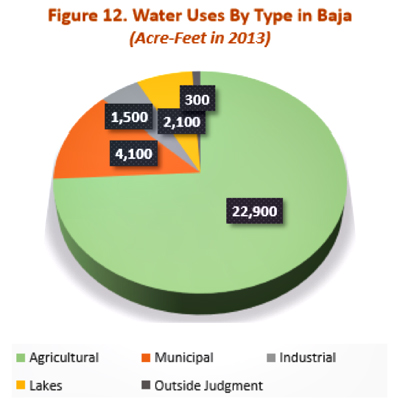Newberry Springs Lakes
Are Being Choked
|
Water studies support lower lake impacts than expected.
 Water to a lake is the breath of life.
Water to a lake is the breath of life.
Sun may be setting upon the lakes as continued rampdowns and uncertainty are depressing real estate market values.
|
December 29, 2014
 Data from the groundwater sustainability plan
Data from the groundwater sustainability plan
indicates the lakes have minimal impact.
This article is being written to dispel the notion that the Newberry
Springs Lakes waste water.
It is well documented by the Mojave Water Agency, and
by well reports, that all the lakes in the region as a whole use only 6.8% of the total
water pumped in the basin. This 6.8% also includes many of the lakes homeowner's
domestic water use.
Compared to agriculture that pumps 75% of the basin's water,
the lakes are not even close to pumping the same volume as agriculture.
In fact, the lakes recirculate most of the water that they pump back into
the aquifers. Thus, the only minor water loss is evaporation.
Most folks agree that this is a relatively small amount of water usage as
compared to the agriculture water producers in the area, and the lakes and the homeowners have
contributed to the Newberry Springs area for over 40 years through recreational, social,
economic and wildlife benefits.
Lake facts.
1. There are over 300 homes on the Newberry Springs lakes.
2. These homeowners pay property tax at a higher rate, because the value is
much greater when you have a lake on your property. Good for the schools,
roads, and the Newberry Community Service District.
3. Many lake owners are your neighbors, doctors, teachers, law enforcement
officers, and many more families that help make this small community a great
place to live.
4. The lakes only use 6.8% of the water, as stated in the Baja Areawide Sustainability
Plan draft on page 36. (Chart below.)
5. The lakes are water recirculators, only the evaporatived water is lost
water.
6. The lake owners cannot change the evaporative rate of their lakes nor reduce their size
to regulate water pumping; unlike agriculture that can make their irrigation more
efficiently, change to a crop that uses less water, or reduce the number of crop cycles.
7. Unlike agriculture, the lakes are not profitable businesses that make money,
they are homeowner associations.
8. If you divided the number of homes on a lake by the amount of lake surface
area, you would see that it only amounts to a small pond per home. Less that
½ acre per home on average.
9. The lakes owners support the management idea of a sustainable water table
in Mojave Valley.

Water Pumpers Pie Chart
Here is a breakdown of the water users in the Baja basin, as of 2013
(page 36 of the draft Baja Areawide Sustainability Plan):
1. Agriculture (alfalfa farmers mostly) 75% of the water pumped.
2. Minimal Producers (regular homes) some have small ponds 13.3%
3. Lakes (Large Lakes) 6.8%
4. Industrial 5%
5. Other 1%
As shown, the lakes are very similar to the residential
minimal producers; however, they are treated harshly. The current
rampdown of the Free Production Allowance (FPA) by Mojave Water Agency (MWA) has
reduced the amount of water that the lakes are able to pump for free, so they now
have to purchase make-up water. The water pumped to maintain the historical
residential lake levels is the same, but the lake homeowners are selectively penalized
to pay more.
Most of the lakes purchase carry over water
rights from water owners that do not use the water they have a right to.
As an example, one lake only has 40 acre feet of FPA left because
of the current rampdown. It has to purchase about 100 acre feet per year as make-up
water. This lake has 13 homes on it, if they were 13 individual properties
that are allowed 10 acre feet of FPA, they would be allowed 130 acre feet of water
for free. So in many cases, the lakes have been treated worse that the minimal
producers and have to purchase water every year.

It's a no brainer where most of the water in the basin is going.
The lakes are willing to discuss water saving issues with any of the stakeholders
in Mojave Valley. And we will do our part in saving water and being good neighbors
to all that live and work here.
Our properties have seen a big decline in value because of the
uncertain availability of water. What would the value of a home be with a
large hole in the front yard? Most lakes would be abandoned by the owners,
and millions of dollars of property value would be lost. Not to mention, the
abandoned properties would be a great eyesore to the community. You might
as well take Newberry off the map.
Lakes have been in the Baja basin since the 1960's,
and many animal and bird species have become dependent on the water the
lakes provide.
What would this valley look like without the lakes?
Not very appealing.
Let's hope it will not come to that so our community
will survive.
Submitted by the Newberry Springs Recreational Lakes Association
Click here to "Like,"
contribute info, or share on:

|
Follow us on Twitter and
be notified of new stories:

|
• • •
Home: http://NewberryInfo.com